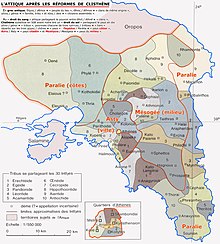Aiantis

Aiantis (Ancient Greek: Αἰαντίς) was a phyle of ancient Attica with six demes:[1] Aphidna, Marathon, Oenoe, Rhamnous, Tricorythus and Phalerum.[2] It was named in honour of Ajax the Great.

Marathon is located within the boundaries of this place.[3]
It is attested by Plutarch that fifty-two members of the tribe of Aiantis died from wounds sustained in the Battle of Plataea.[4]
The playwright Aeschylus came from deme Eleusis in Aiantis.[5] His family were eupatrids.[6]
References
- ^ JS. Traill - The Political Organization of Attica: A Study of the Demes, Trittyes, and Phylai, and Their Representation in the Athenian Council, Volumes 14-16 (p.13) ASCSA, 1975 ISBN 0876615140 [Retrieved 2015-04-17]
- ^ A Missiou (Associate Professor of Ancient Greek History at the University of Crete) - Literacy and Democracy in Fifth-Century Athens (p.18) Length 211 pages Cambridge University Press, 17 Feb 2011 ISBN 0521111404 [Retrieved 2015-04-18](Efharisto, Efharistoomay)
- ^ P Vidal-Naquet - director of the Centre de Recherches comparées sur les Sociétés Anciennes at the Ecole des Hautes Etudes en Sciences Sociales in Paris c,1998 - The Black Hunter: Forms of Thought and Forms of Society in the Greek World (p.91) translated by A Szegedy-Maszak, JHU Press, 9 Jul 1998 (reprint) ISBN 0801859514 [Retrieved 2015-04-18]
- ^ JD. Mikalson (William R. Kenan Jr. Professor of Classics at the University of Virginia) - Herodotus and Religion in the Persian Wars Univ of North Carolina Press, 15 Sep 2003 ISBN 0807862010 [Retrieved 2015-04-18]
- ^ Sekunda, Nicholas (2002). Marathon 490 BC: The first Persian invasion of Greece. Campaign 108. Osprey Publishing. p. 53. ISBN 1841760005.
- ^ (edited by FN Magill) The Ancient World: Dictionary of World Biography, Volume 1 Routledge, 16 Dec 2003 ISBN 1135457395 [Retrieved 2015-04-18]
